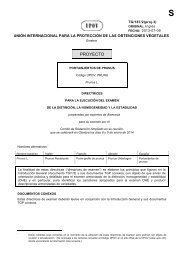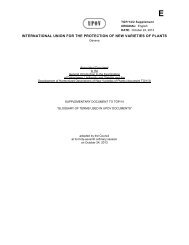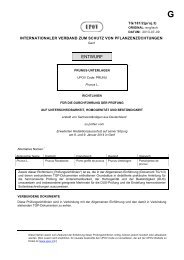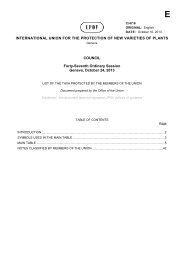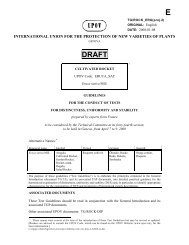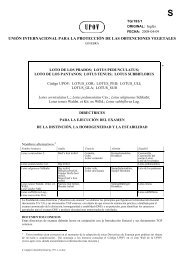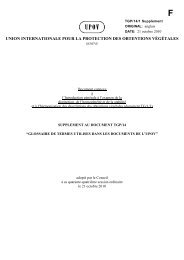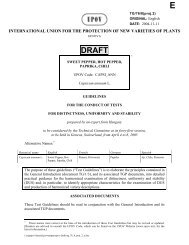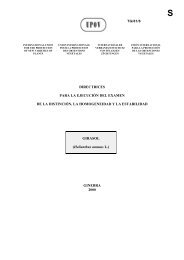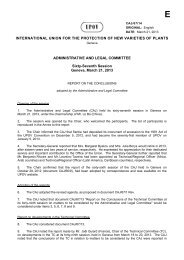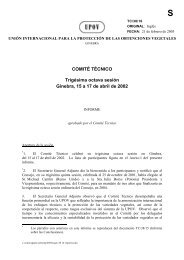E - International Union for the Protection of New Varieties of Plants
E - International Union for the Protection of New Varieties of Plants
E - International Union for the Protection of New Varieties of Plants
Create successful ePaper yourself
Turn your PDF publications into a flip-book with our unique Google optimized e-Paper software.
TGP/14/1: Section 2: Botanical Terms<br />
Subsection 2: Shapes and Structures: III. DEFINITIONS FOR SHAPE AND STRUCTURE TERMS<br />
page 68<br />
Term<br />
Open<br />
Orbicular<br />
Outwards<br />
Ovate<br />
Ovoid<br />
Panicle<br />
Pannose<br />
Papillose<br />
Papyraceous,<br />
Papery<br />
Pear-shaped<br />
Pedicelled<br />
(Pedicellate)<br />
Peltate<br />
Pendent<br />
Pendulous<br />
Perpendicular<br />
Pilose<br />
Pointed<br />
Pointed<br />
Prickly<br />
Procumbent<br />
Pr<strong>of</strong>ile<br />
Definition / comment<br />
Term used to describe plants with sparse branches or foliage.<br />
use “Circular”<br />
a plant part/ plant parts facing outwards in relation to <strong>the</strong> whole plant or in relation<br />
to o<strong>the</strong>r relevant plant parts, e.g. <strong>the</strong> corolla facing outwards in relation to <strong>the</strong><br />
longitudinal axis <strong>of</strong> <strong>the</strong> flower. Compare ‘inwards’.<br />
Chicken-egg-shaped; broadest below <strong>the</strong> middle, that is towards <strong>the</strong> point <strong>of</strong><br />
attachment, <strong>the</strong> margin entirely convex, although <strong>the</strong> apex may be ei<strong>the</strong>r rounded<br />
or pointed. Compare <strong>the</strong> ‘obovate’ series which is broadest towards <strong>the</strong> apex and<br />
‘ovoid’ which applies to three-dimensional shape.<br />
Chicken-egg-shaped; broadest below <strong>the</strong> middle, that is towards <strong>the</strong> base, entirely<br />
convex, although <strong>the</strong> apex may be ei<strong>the</strong>r rounded or pointed. Compare <strong>the</strong><br />
‘obovoid’ series which is broadest towards <strong>the</strong> apex and ‘ovate’ which applies to<br />
two-dimensional shape.<br />
a definite inflorescence that is increasingly more strongly and irregularly branched<br />
from <strong>the</strong> top to <strong>the</strong> bottom and where each branching has a terminal flower.<br />
Covered by <strong>the</strong> general term “hair” in <strong>the</strong> Test Guidelines. Felted; densely<br />
covered with short, matted, intertwined hairs.’ Compare ‘tomentose’ which is less<br />
matted.<br />
Pimpled, with small, rounded, s<strong>of</strong>t to firm, unequal bumps. Compare ‘bullate’<br />
which has flatter, blister-like convexities.<br />
With <strong>the</strong> consistency <strong>of</strong> paper; thin and somewhat opaque. Compare<br />
‘membranous’ which is more transparent.<br />
See ‘pyri<strong>for</strong>m’.<br />
An individual flower or fruit borne on a stalk.<br />
Shield-shaped; applies to a stalked plant part, normally circular in shape and with<br />
<strong>the</strong> stalk attached at or near <strong>the</strong> center <strong>of</strong> <strong>the</strong> lower surface.<br />
Hanging downwards due to its own weight. Compare ‘pendulous’. Compare<br />
‘drooping’ and ‘weeping’, which are ‘bending downwards’, ‘weeping’ being more<br />
pronounced than ‘drooping’.<br />
Hanging downwards, due to <strong>the</strong> weakness <strong>of</strong> its support. Compare ‘pendent’.<br />
At right angle to ano<strong>the</strong>r plant part.<br />
Covered by <strong>the</strong> general term “hair” in <strong>the</strong> Test Guidelines. With long, s<strong>of</strong>t, sparse,<br />
slender trichomes. Compare ‘villous’ which is more shaggy.<br />
A general term <strong>for</strong> a base or apex which can be ‘acute’ (90°).<br />
For <strong>the</strong> base, <strong>the</strong> term cuneate may be used instead <strong>of</strong> ‘pointed’.<br />
A general term <strong>for</strong> a base or apex, etc. with straight or slightly convex margins<br />
terminating in a sharp or blunt tip. Compare ‘acute’ (90°).<br />
See ‘aculeate’.<br />
Growing flat on <strong>the</strong> ground but not rooting at <strong>the</strong> nodes. Compare ‘stoloniferous’<br />
rooting at <strong>the</strong> nodes.<br />
In <strong>the</strong> UPOV Test Guidelines, <strong>the</strong> term “shape” should be used in its broadest<br />
sense and <strong>the</strong> use <strong>of</strong> terms such as “<strong>for</strong>m” and “pr<strong>of</strong>ile” should be avoided to<br />
minimize discrepancies in translation



